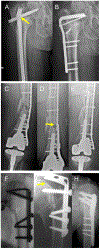Finite Element Analysis of Fracture Fixation
- PMID: 34185266
- PMCID: PMC8422380
- DOI: 10.1007/s11914-021-00690-y
Finite Element Analysis of Fracture Fixation
Abstract
Purpose of review: Fracture fixation aims to provide stability and promote healing, but remains challenging in unstable and osteoporotic fractures with increased risk of construct failure and nonunion. The first part of this article reviews the clinical motivation behind finite element analysis of fracture fixation, its strengths and weaknesses, how models are developed and validated, and how outputs are typically interpreted. The second part reviews recent modeling studies of the femur and proximal humerus, areas with particular relevance to fragility fractures.
Recent findings: There is some consensus in the literature around how certain modeling aspects are pragmatically formulated, including bone and implant geometries, meshing, material properties, interactions, and loads and boundary conditions. Studies most often focus on predicted implant stress, bone strain surrounding screws, or interfragmentary displacements. However, most models are not rigorously validated. With refined modeling methods, improved validation efforts, and large-scale systematic analyses, finite element analysis is poised to advance the understanding of fracture fixation failure, enable optimization of implant designs, and improve surgical guidance.
Keywords: Biomechanics; Finite element analysis; Fracture fixation; Nail; Plate; Screw.
© 2021. The Author(s), under exclusive licence to Springer Science+Business Media, LLC, part of Springer Nature.
Figures



References
-
- Burge R, Dawson-Hughes B, Solomon DH, Wong JB, King A, Tosteson A. Incidence and economic burden of osteoporosis-related fractures in the United States, 2005–2025. J Bone Miner Res. 2007;22:465–75. - PubMed
-
- Brinker MR, Hanus BD, Sen M, O’Connor DP. The devastating effects of tibial nonunion on health-related quality of life. J Bone Joint Surg Am. 2013;95:2170–6. - PubMed
-
- Brinker MR, Trivedi A, OʼConnor DP. Debilitating Effects of Femoral Nonunion on Health-Related Quality of Life. J Orthop Trauma. 2017;31:e37–42. - PubMed
-
- Hak DJ, Fitzpatrick D, Bishop JA, Marsh JL, Tilp S, Schnettler R, et al.Delayed union and nonunions: epidemiology, clinical issues, and financial aspects. Injury. 2014;45 Suppl 2:S3–7. - PubMed
-
- Rupp M, Biehl C, Budak M, Thormann U, Heiss C, Alt V. Diaphyseal long bone nonunions - types, aetiology, economics, and treatment recommendations. Int Orthop. 2018;42:247–58. - PubMed
Publication types
MeSH terms
Grants and funding
LinkOut - more resources
Full Text Sources
Medical
Research Materials

